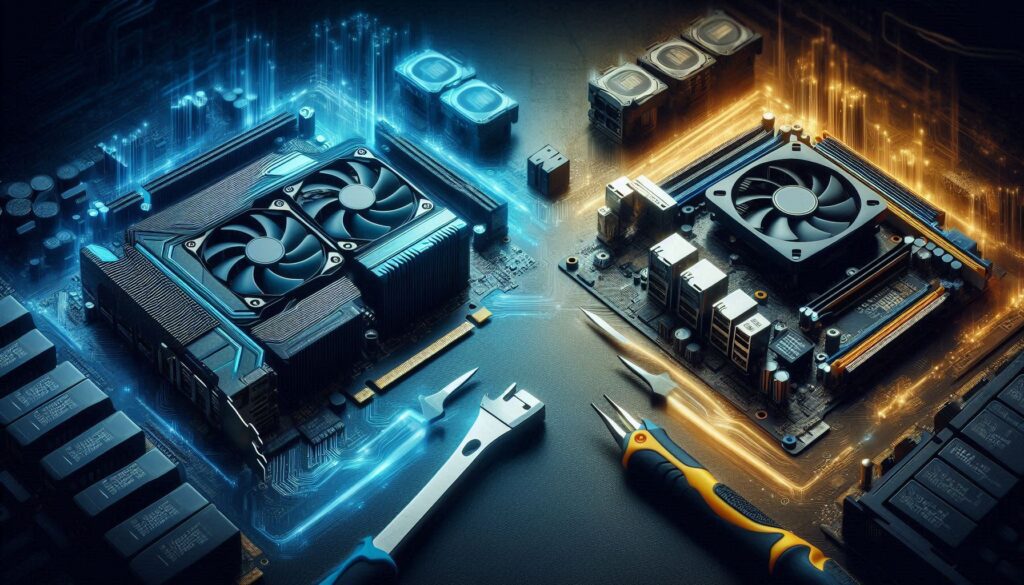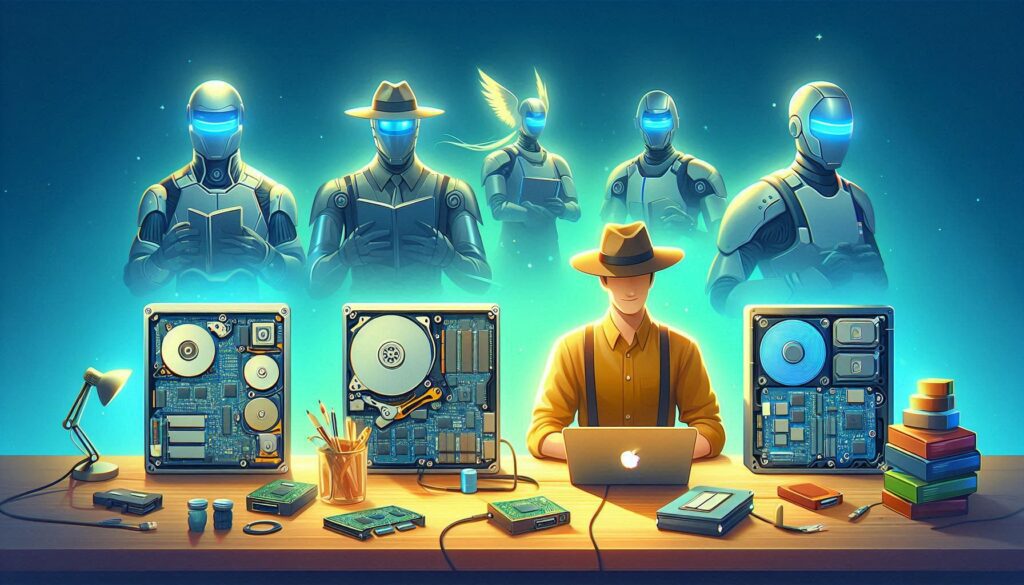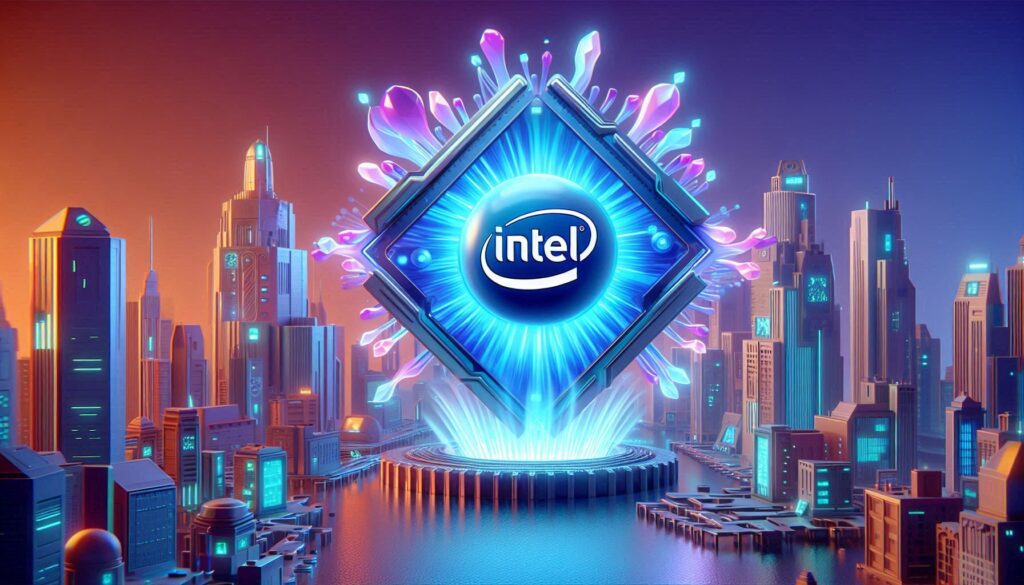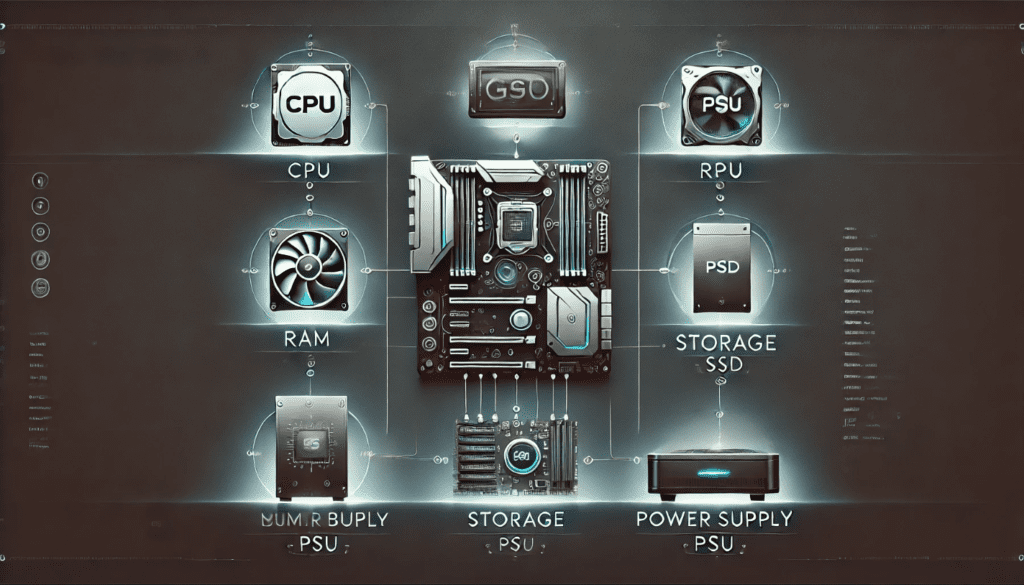How Much RAM Do You Really Need for Gaming in 2024?
Discover how much RAM you need for optimal gaming in 2024. From 8GB to 64GB, learn what suits casual play to high-end multitasking and future-proofing.
Understanding CPU Cores and Threads: What Really Matters?
Learn about CPU cores and threads to choose the best processor for gaming, multitasking, or content creation.
Guide to BIOS Settings: Tweaking Your Motherboard for Performance
Optimize your PC with BIOS tweaks. Learn about CPU overclocking, RAM tuning, storage settings, and cooling control for better performance and stability.
ATX vs. Micro ATX vs. Mini ITX: Choosing the Perfect Motherboard for Your PC Build

Compare ATX, Micro ATX, and Mini ITX motherboards to find the perfect fit for your PC build. Explore features, expandability, and ideal use cases.
PCIe 4.0 vs PCIe 5.0: Which One Is Right for Your Next Build?

Compare PCIe 4.0 and PCIe 5.0 to decide the best for your PC. Explore bandwidth, performance, and future-proofing to optimize your gaming or workstation.
Comparing HDD, SSD, and NVMe Storage: Which One Is Right for You?

Discover the key differences between HDD, SSD, and NVMe storage. Learn which option offers the best performance, speed, and value for your needs.
A Deep Dive into AMD Processor Generations: Release Dates, Key Features, and Comparison with Intel
Explore the evolution of AMD processors, from Athlon to Ryzen, comparing key features, performance, and how they stack up against Intel’s CPUs.
Intel Core Ultra: The Next Big Leap in Computing Power

Discover Intel Core Ultra, the latest high-performance processor with AI features, hybrid cores, DDR5, and PCIe 5.0 support for gaming and content creation
Intel Generations (Processor): 1 to 14
Here’s an overview of each generation, their release dates, and key improvements:
7 Essential PC Components for Your Next Build: A Guide to Choosing the Best CPU, GPU, RAM, and More

When building a PC, here are the 7 basic components you need, along with factors to consider when selecting them: 1. Processor (CPU) A CPU (Central Processing Unit) is like the brain of a computer. Its main job is to carry out instructions and process data so that everything on your computer works properly. When you open a program, click on something, or type, the CPU is responsible for figuring out what needs to be done and making sure it happens quickly. In simple terms, the CPU: Processes Information: It takes in data, follows instructions, and performs calculations. Runs Programs: Any app or software you use is managed by the CPU, whether it’s for work, entertainment, or browsing the web. Coordinates Everything: The CPU communicates with other parts of the computer, like memory and storage, to keep things running smoothly. Following factors should be considered while selecting a Processor: Performance: Choose based on tasks (gaming, content creation, general use). Consider cores/threads. Brand: Intel vs. AMD. AMD often offers better multi-core performance for productivity, while Intel might have stronger single-core performance. Compatibility: Ensure your CPU is compatible with your motherboard (socket type). 2. Motherboard A motherboard is like the central hub or backbone of your computer. It holds and connects all the important parts, like the CPU, memory (RAM), storage, and other components, allowing them to work together. Here’s a simple explanation of what the motherboard does: Connects Everything: It links the CPU, memory, storage, and other hardware (like your keyboard, mouse, and screen) so they can communicate and work as a team. Supplies Power: The motherboard helps distribute electricity from the power supply to different components, ensuring everything gets the power it needs to function. Holds Components: Key parts like the CPU, RAM, and graphics card plug directly into the motherboard, keeping everything in one place. In short, the motherboard is like the “body” of the computer, with the CPU as the “brain” and everything else plugged into it to keep the whole system running smoothly. Following factors should be considered while selecting a Motherboard: Compatibility: Must support your CPU (socket type) and RAM (DDR4/DDR5). Form Factor: ATX, Micro-ATX, Mini-ITX depending on case size and expansion needs. Features: Consider the number of PCIe slots, USB ports, and support for NVMe storage. Chipset: Higher-end chipsets offer more features (e.g., overclocking support, faster RAM speeds). 3. Memory (RAM) RAM (Random Access Memory) is like the short-term memory of your computer. It temporarily stores the data and information that your computer needs right now, making everything faster and smoother while you’re working. Here’s a simple breakdown of what RAM does: Speeds Things Up: When you open a program or file, RAM stores the data temporarily so the CPU can access it quickly. This helps your computer run faster without having to constantly pull data from slower storage (like a hard drive or SSD). Multitasking: RAM allows your computer to handle multiple tasks at once, like having several programs open at the same time without slowing down. Temporary Storage: Unlike your hard drive, which stores data permanently, RAM only holds information while the computer is on. Once you shut down or restart, everything in RAM is erased. In simple terms, RAM helps your computer do things quickly and efficiently while you’re using it, making it easier to multitask and run programs smoothly. Following factors should be considered while selecting a RAM: Capacity: 16GB is often the minimum for gaming; 32GB is recommended for more demanding applications. Speed: Higher clock speeds (MHz) improve performance, especially in memory-intensive tasks. DDR4 RAM typically ranges from 2400MHz to 3600MHz, while DDR5 can go from 4800MHz to 6400MHz and higher. The higher the frequency, the better the performance in tasks that require fast data transfer between RAM and the CPU. Compatibility: Ensure the RAM type (DDR4/DDR5) is supported by your motherboard. CAS Latency (CL): It is the number of clock cycles it takes for the RAM to respond to a command from the CPU. Lower latency means faster response time. DDR4 RAM usually has a CL ranging from 14 to 19, while DDR5 typically has a higher CL, often starting at 32 or higher due to the increased frequency. 4. Graphics Card (GPU) A GPU (Graphics Processing Unit) or graphics card is like the artist of your computer. Its job is to handle everything related to visuals and images, so what you see on your screen looks smooth and sharp. Here’s a simple explanation of what a GPU does: Renders Images and Videos: The GPU creates all the visuals you see, whether it’s images, videos, or the graphics in games. It processes this visual data much faster than the CPU can, which makes everything look clear and smooth. Helps with Gaming and Graphics: If you play video games or work with graphic design, video editing, or 3D modeling, the GPU is crucial for delivering high-quality visuals and performance without slowing down. Takes Load Off the CPU: The GPU specializes in handling visual tasks, which frees up the CPU to focus on other things, making your computer run more efficiently overall. In short, the GPU is responsible for creating all the graphics you see on your screen, making sure they look great and run smoothly, especially in games or high-definition videos. Following factors should be considered while selecting a Graphics Card: Performance Needs: High-end GPUs are essential for gaming, video editing, or 3D rendering. Look for VRAM capacity (e.g., 8GB to 16GB). Resolution: Choose based on the resolution and refresh rate of your monitor (1080p, 1440p, 4K). Price-to-Performance: Find a balance between your budget and gaming or rendering performance. 5. Storage (SSD/HDD/NVMe) Storage is where your computer keeps all your files, programs, and data permanently, even when it’s turned off. There are different types of storage, each with its own advantages: HDD (Hard Disk Drive) How It Works: HDDs use spinning magnetic disks to read and write data. Speed: Slower compared to modern options, but still good for basic
